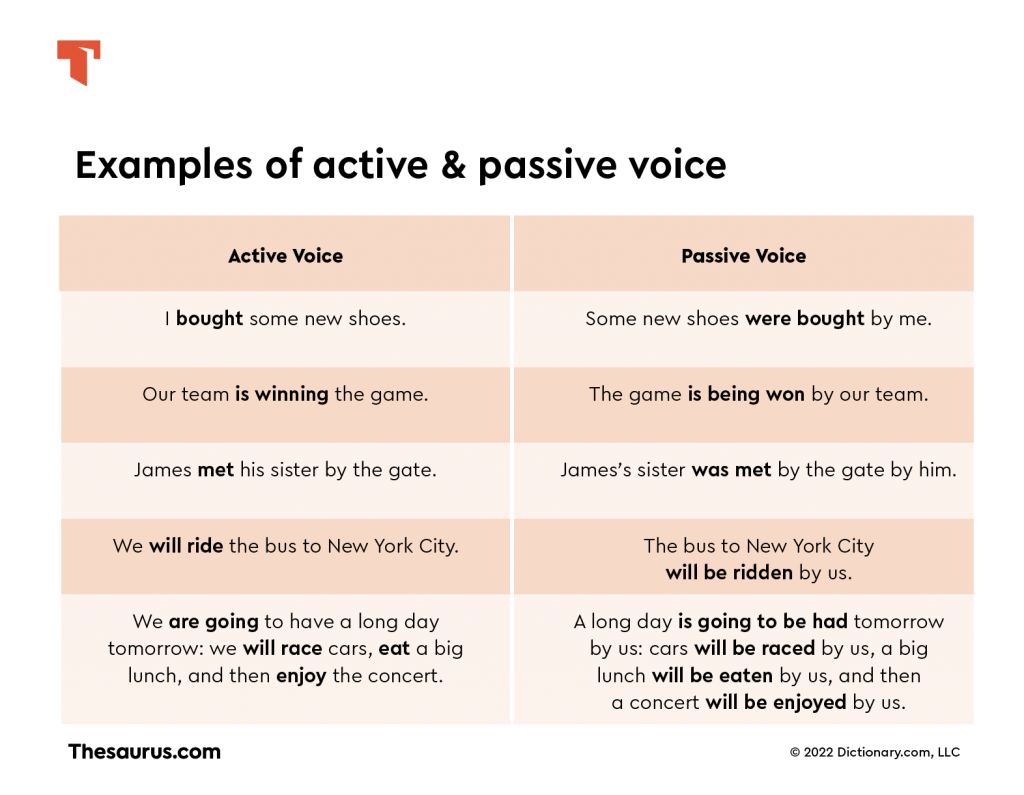Sometimes, it’s best to take the direct approach. When we want to do this in grammar, we use the active voice.
The active voice gets straight to the point and tells us who did what in both shorter sentences like I ran and longer ones like I carefully ran to the store in order to buy the last inflatable gorillas they had on sale. If you’ve been writing or speaking English for a while, you’ve probably been using the active voice most of the time without even knowing it. That being the case, it is only fair that we learn a little more about our very active friend and the best ways to use the active voice in our speech and writing.
What is the active voice?
The active voice is one of two “voices” of verbs that we use in writing and speech. A verb is said to be in the active voice when the subject of a sentence or clause is the one performing the action described by the verb. For example, the sentence Rose hugged her sister uses a verb in the active voice because the subject Rose is the one that performed the action described by the verb hugged. Rose is both the subject and the one who did the hugging.
This all sounds simple enough, right? We tend to use verbs in the active voice in so much of our writing and speech, so you should be pretty familiar with using it already. There are no special rules when it comes to using verbs in the active voice: as long as the subject is actually the one performing the action of the verb, the verb is in the active voice.
If the subject is receiving the action rather than performing the action, it is not using the active voice. For example, the sentence Matt was poked by a chimpanzee does not use a verb in the active voice. If you look closely, you will see that the subject Matt is not performing the action described by the verb poked. Matt didn’t poke anything; a chimpanzee poked him. This is an example of a sentence that uses the other voice of verbs: the passive voice. We will explore the difference between the two voices more later.
There’s something else to keep in mind. Both transitive and intransitive verbs can use the active voice. A transitive verb is “a verb accompanied by a direct object and from which a passive can be formed.” For example, in the sentence Jenny kicked the ball, the ball is the direct object because it is the thing that Jenny kicked. Kicked is in the active voice.
Also, as long as the subject is the one performing an action, intransitive verbs can use the active voice, too. For example, both of the following sentences use the active voice:
- The boy walked the dog. (Transitive verb walked.)
- The babies are peacefully sleeping. (Intransitive verb sleep)
In both sentences the subjects (boy and babies) are the performers of the actions (walked and are sleeping).
Although we don’t think of them as describing “actions,” stative verbs refer to emotions and opinions (such as like, belong, or doubt) can also be used in the active voice. In this case, we consider whether or not the figurative action of the subject is targeted toward something else by the verb. Let’s explain with some examples:
- Romeo loves Juliet.
- I think kittens are adorable.
Both of the above sentences use stative verbs in the active voice. However, the subject of each sentence is the one performing the action described by the verb. Looking at it this way, you can see that a sentence like She hates broccoli uses the active voice while the sentence Broccoli is hated by her does not.
Don’t confuse active voice with action verbs. Find out the details about action verbs here.
Examples of active voice
Let’s look at a variety of sentences that use verbs in the active voice. As you read each one, you’ll see that the subject of each sentence or clause is directly performing an action.
- Julian read books by the fireplace.
- Fred, Daphne, and Wilma searched the spooky mansion.
- The quick brown fox jumps over the lazy dog.
- The strict teacher ignored the wiley student’s attempts to get out of taking the test.
- The rain poured, the thunder boomed, and the lightning crashed.
- I forgot where I hid my passport.
When do you use active voice?
Generally speaking, the active voice is the preferred voice in formal and academic writing. It is seen as more direct and often makes sentences easier to read or understand. Even in casual speech and writing, the active voice tends to come more naturally to most people. That being said, there are specific instances where the active voice is particularly useful.
When writing shorter sentences
Often, the active voice results in shorter, more direct sentences than the passive voice. You can see this is the following two sentences:
- Active: I saw her. (Three words)
- Passive: She was seen by me. (Five words)
To give sentences a sense of authority
Because the performer of an action cannot be omitted in a sentence that uses the active voice, the active voice often sounds more authoritative. You’ll notice this difference in the following two sentences:
- Active: The president made the decision.
- Passive: The decision was made.
Even if the performer of an action isn’t omitted, the passive voice often sounds weaker and less impactful because it typically shifts the focus away from the performer:
- The decision was made by the president.
To make sentences easier to understand and absorb
As mentioned earlier, the active voice is more direct than the passive voice. As a result, sentences that use the active voice are usually easier to understand than the often rambling and confusing sentences written in passive voice. For example,
- Active: I finished my homework and then met my friends at the mall. They told me that Ashley was going to be late.
- Passive: The homework was finished by me before my friends were met by me at the mall. The fact that Ashley was going to be late was told to me by them.
When should you avoid active voice?
In general, the active voice is rarely considered inappropriate or “wrong.” However, there may be times when the passive voice may be the better option to use.
The performer is unimportant, obvious, or unknown
If an actor is not known, is unimportant, or is obvious, the passive voice may be used. For example,
- The man was sentenced to 10 years in prison. (The action was obviously performed by a judge.)
- An escaped tiger was seen prowling the city. (It isn’t important who specifically saw the tiger.)
- The car was stolen! (It is unknown who stole the car.)
Avoiding blame
Because the active voice always identifies a performer of an action, it may not be used if a person doesn’t want to assign the blame to someone.
- Active: Travis broke the fence. (Travis is taking the blame.)
- Passive: The fence was broken. (Nobody is taking the blame.)
Shifting the focus of a sentence
By using the passive voice rather than the active voice, we can shift the focus away from the performer of an action and toward the receiver of an action.
- Active: Many important people attended the fancy dinner party. (The focus is on the people.)
- Passive: The fancy dinner party was attended by many important people. (The focus is on the party.)
How to fix passive voice
In general, you will often be warned against using passive voice or told to correct writing or speech that overuses it. Let’s look at an example of a passive voice sentence and then consider how to change it into an active voice sentence.
- Example: The mice are being chased by the hungry cat.
First, identify who or what is actually performing an action. In this sentence, we can see that the hungry cat is the performer. So, the hungry cat will become the subject of our active voice sentence.
Next, we get rid of the verb be and change the past participle into a correctly conjugated verb that agrees with our new subject. In this case, it makes sense to use the verb chase in the present continuous tense: is chasing.
Finally, we make the old subject into the direct object of the new active voice sentence if it makes sense to do so. In this case, the mice will become the direct object.
So, our new active voice sentence looks like this:
- The hungry cat is chasing the mice.
Often, you only need to flip the sentence around like this in order to change passive voice to active voice. However, you always need to make sure your new sentence follows subject-verb agreement and doesn’t significantly change the meaning.
Is there a time to use the passive voice? Read more about it to find out.
Passive vs. active voice
We have already looked at a lot of the different ways we use passive vs. active voice. The difference between the two voices is:
- In the active voice, the subject is doing something.
- In the passive voice, the subject is having something done to it.
If you keep this big difference in mind, you’ll have a much easier time keeping active voice and passive voice separate.
Here’s a helpful tip: intransitive verbs mainly use the active voice. The reason why makes sense if you think about what intransitive verbs are. They are verbs that show complete actions but are not accompanied by a direct object or form a passive. (Remember that many verbs have both transitive and intransitive senses.) This might be easier to understand with some examples. The following two sentences show a grammatically correct sentence that uses an intransitive verb in the active voice and a nonsensical sentence that attempts to use an intransitive verb in a passive voice sentence.
- Active: The kids are swimming in the river.
- Passive: The kids are being swum in the river.
Let’s finish things up with a short quiz. Take a look at each of the following sentences and see if you can tell if the verb is using the active or passive voice.
- Diana built a sandcastle.
- The gold watch was purchased by a suspicious customer.
- The birds noisily chirped outside my window.
- My son likes watching cartoons.
- The lions are being trained to perform impressive stunts.
Make an active choice to improve your grammar
Confused about passive and active voice and their proper use? Let Thesaurus.com Grammar Coach™ guide you! This writing platform uses machine learning technology uniquely designed to catch grammar as well as spelling errors. Plus, Grammar Coach™ Synonym Swap will find the best nouns, adjectives, and more to help say what you really mean, guiding you toward clearer, stronger, writing.
Answers: 1. Active 2. Passive 3. Active 4. Active 5. Passive
















